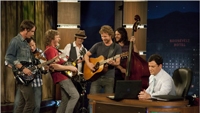ABC’s ‘Jimmy Kimmel Live’ and ‘Nightline’ use Apple products for broadcast-quality production

When a power failure struck the studio of Jimmy Kimmel’s late night ABC show last week, the host picked up his Apple Macbook and used the webcam to shoot the show. ABC aired it the next night, giving Kimmel a huge boost of publicity. The network also used Apple’s new iPhone to shoot an entire segment for its “Nightline” program, further blurring the lines between “broadcast” and consumer equipment suitable for national broadcast.
Kimmel worked as director, cameraman and lighting designer for the night. “I suppose, if I’d thought it out better, I could have taken a video camera and done the same thing,” Kimmel told “The New York Times” after the show.
Kimmel, whose late-night ABC talk show is produced at El Capitan Theater in Los Angeles, said power problems became apparent just before taping was to start Monday at 7 p.m. Pacific time. Following a failure earlier in the day, the show’s control room automatically switched to a backup battery that was soon depleted.
“We were left with no power in the control room,” Kimmel said. “We had lights, but no cameras or audio.” The host instinctively picked up his MacBook, opened the Photo Booth program, and began walking through his offices and interviewing his staffers on its webcam. “I was like, maybe we can do this if we’re not able to get on the air,” he told the newspaper.
The webcam became Kimmel’s only option, as power was not restored to the control room until about 8:40 p.m. — too close to the show’s 9 o’clock live air time. A decision was made to broadcast a Jimmy Kimmel Live rerun on Monday, and air the webcam show on Tuesday. The show was done with minimal editing and went on the air complete with flaws.
Kimmel’s guests and audience were all game to remain at the theater and shoot the webcam episode for Tuesday. Comedian John Henson, a guest, even shot his segment a second time, from his dressing room, when his original studio interview with Kimmel was accidentally recorded without audio.
The show featured segments with Seth Rogen (who introduced his new movie, “The Green Hornet”), as well as a performance by the country musician Dierks Bentley. Though the show was not in high-definition video, it worked well with the low-resolution pictures. Guests held their own microphones.
The professional video industry's #1 source for news, trends and product and tech information. Sign up below.
The very next night, the ABC News show “Nightline” featured a segment announcing the next-day availability of the new Apple iPhone 4, and shot the entire segment with it — with no extra lights, no broadcast cameras and no microphones. Reporter Bill Weir actually used two iPhone 4 models (one to shoot the reporter holding the second iPhone). The 720p HD pictures — live interviews, a re-enactment of a scene from “Gone with the Wind” and images of the phone’s screen — looked great on HDTV sets in viewers’ homes. (You can view the episode “Exclusive Look at Apple iPhone 4” online.)
It’s clear that the future of electronic newsgathering will certainly include consumer-grade products, as the technology continues to improve and offer more professional quality video and audio production creation features.
